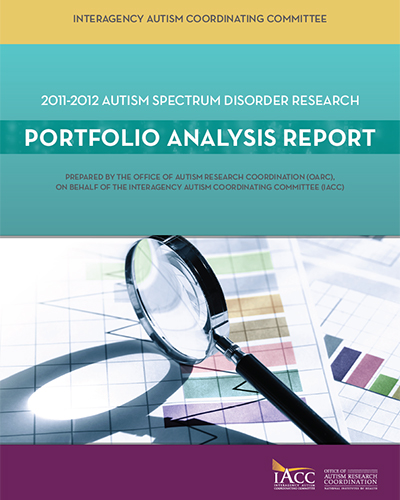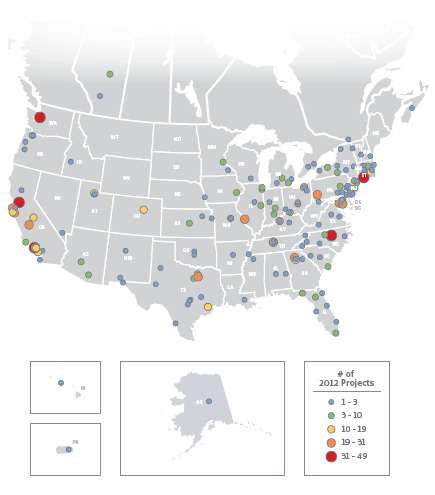Portfolio Analysis Report
IACC Autism Spectrum Disorder Research
2011 - 2012
The Office of Autism Research Coordination (OARC) requested 2011 and 2012 autism-related research project and funding information from several Federal agencies and private organizations, including the annual budget for each project and its relevance to the seven critical questions/chapters of the 2011 IACC Strategic Plan for ASD Research, illustrated below (Figure 1).
IACC Strategic Plan Questions and Corresponding Research Areas
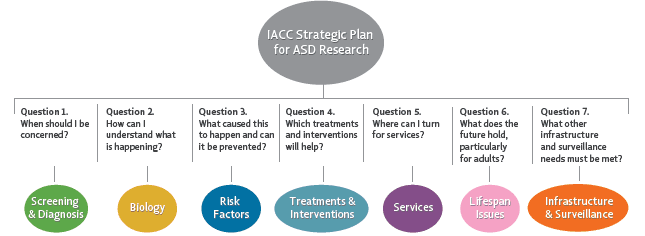
Figure 1. The research areas corresponding to the seven questions of the 2011 IACC Strategic Plan for ASD Research are designated in the oval above each question.
Twelve Federal agencies and eight private funders provided their autism funding data for this analysis. These 20 agencies and organizations are listed in Table 1. Funders submitting data for the first time include: the Administration for Community Living (ACL), a component agency within HHS that was formed in 2012; the U.S. Air Force (AF); the Substance Abuse and Mental Health Services Administration (SAMHSA); and the Brain & Behavior Research Foundation (BBRF).
Agencies and Organizations Included in the 2010 IACC Portfolio Analysis
| Federal Agencies | Private Organizations |
|---|---|
Federal Agencies
Private Organizations
|
* The DoD Autism Research Program and Air Force reported as two separate entities for the purpose of this Portfolio Analysis.
Table 1. Projects from 12 Federal agencies and eight private organizations were included in the 2011-2012 IACC Autism Spectrum Disorder Research Portfolio Analysis Report.
How much ASD research was funded in 2011 and 2012?
Combined, the estimated Federal and private investment in ASD research in 2011 and 2012 was $299,879,145 and $331,949,933 respectively. While overall funding for autism research increased by $32 million from 2011 to 2012, the proportions of Federal and private funding remained constant over this period. In both 2011 and 2012, the Federal government provided 78% ($233.1 million in 2011 and $260.1 million in 2012) and private organizations provided 22% ($66.8 million in 2011 and $71.8 million in 2012) of the total funding for ASD research (Figures 2 and 3).
2011 Federal vs. Private Funding for ASD Research
Total Funding: $299,879,145
Number of Projects: 1,227
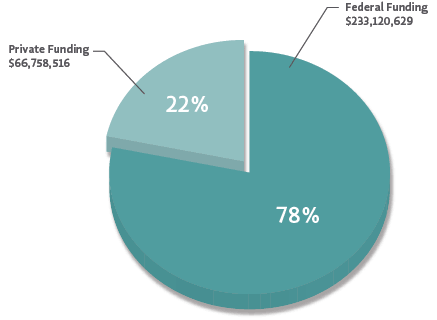
2012 Federal vs. Private Funding for ASD Research
Total Funding: $331,949,933
Number of Projects: 1,312
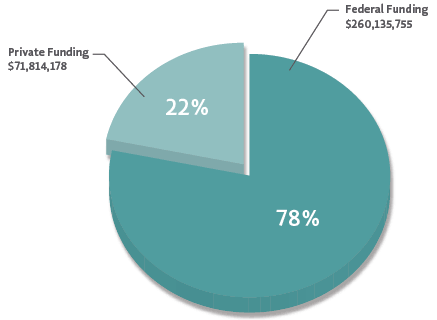
Figure 2 & 3. In 2011 and 2012, 78% of ASD research funding was provided by Federal sources, while 22% of funding was provided by private organizations.
What Fundings Trends were Observed?
- Combined Federal and private investment in ASD research decreased from 2010 ($348.6 million) to 2011 ($299.9 million) and 2012 ($331.9 million).
- Private investment in ASD research was lower in 2011 ($66.8 million) and 2012 ($71.8 million) than in previous years (compare to $78.5 million in 2008, $77 million in 2009, and $74.1 million in 2010), possibly reflecting changes in the U.S. economy. However, there was an increase in private funding for autism research from 2011 to 2012.
- The amount of Federal investment in autism research reported in 2011 ($233.1 million) and 2012 ($260.1 million) was lower than the amount reported in 2010 ($334.4 million).
- One factor that may have contributed to the decrease in overall and Federal funding for ASD research from 2010 to 2011 and 2012 is the American Recovery and Reinvestment Act (ARRA), which provided an additional $63.9 million in 2009 and $59.9 million in 2010 that was used to support autism research projects, creating a temporary increase in autism research funding levels during those years (Figure 4).
- Another factor that may have contributed to changes in overall funding levels is that adjustments were made in the reporting of funding for some ASD services research-related projects starting in 2011. Services projects in which the research component was minimal or projects that were not ASD-specific, but focused on disabilities in general, were not included. Additionally, some large services-related projects that included ASD among multiple disabilities or contained specific portions that pertain to services research were prorated in 2011 and 2012 to reflect only the portions of the projects that are directly relevant to autism research described in the IACC Strategic Plan objectives.
- Finally, additional Federal funders were added to the 2011-2012 Portfolio Analysis, in accordance with the IACC’s goal to make the analysis as comprehensive and current as possible and to ensure it reflects the actual state of the field. It should be noted, however, that the funders added to the analysis in 2011 and 2012 contributed only a small number of projects, so the impact of these new projects on the total funding figures was relatively small.
Combined Federal and Private Autism Research Funding 2008-2012
(millions of dollars)
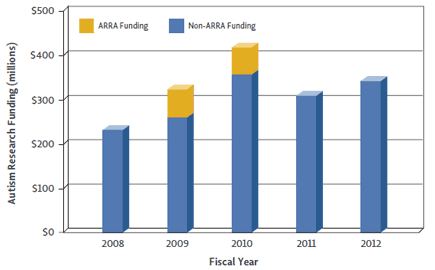
Figure 4. This figure illustrates levels of autism research funding from combined Federal and private sources during 2008-2012 based on data collected for the IACC Portfolio Analysis of those years.
Where is research being funded in the U.S.?
Figure 5 shows the distribution of autism research projects across the U.S. funded by both Federal agencies and private organizations in 2012. The map shows that research is concentrated along the east and west coasts of the U.S. and in major metropolitan areas or areas with large universities in the middle portion of the country. Figure 6 provides some additional information about the institutions and states that received the most research funding in 2011 and 2012.
Figure 5. A map of the U.S. and Canada displaying the distribution of autism-related research projects funded by Federal agencies and private organizations.
aWhich U.S. institutions received the most autism research funding in 2011 and 2012?
| Institution | 2011 Funding | 2011 Project Count |
|---|---|---|
InstitutionNational Institutes of Health-Intramural Research Program | 2011 Funding$19,983,481 |
2011 Project Count15 |
InstitutionYale University | 2011 Funding$15,492,159 |
2011 Project Count38 |
InstitutionUniversity of California, Davis | 2011 Funding$12,912,674 |
2011 Project Count45 |
InstitutionUniversity of North Carolina at Chapel Hill | 2011 Funding$12,736,747 |
2011 Project Count40 |
InstitutionUniversity of California, Los Angeles | 2011 Funding$10,879,866 |
2011 Project Count35 |
InstitutionUniversity of California, San Diego | 2011 Funding$6,350,978 |
2011 Project Count27 |
InstitutionStanford University | 2011 Funding$6,077,507 |
2011 Project Count29 |
InstitutionUniversity of Washington | 2011 Funding$6,037,668 |
2011 Project Count24 |
InstitutionVanderbilt University | 2011 Funding$5,507,610 |
2011 Project Count25 |
InstitutionRutgers, The State University of New Jersey | 2011 Funding$5,468,663 |
2011 Project Count3 |
| Institution | 2012 Funding | 2012 Project Count |
|---|---|---|
InstitutionNational Institutes of Health-Intramural Research Program | 2012 Funding$28,959,454 |
2012 Project Count18 |
InstitutionUniversity of North Carolina at Chapel Hill | 2012 Funding$16,836,300 |
2012 Project Count44 |
InstitutionYale University | 2012 Funding$15,404,956 |
2012 Project Count49 |
InstitutionUniversity of California, Los Angeles | 2012 Funding$13,528,767 |
2012 Project Count44 |
InstitutionUniversity of California, Davis | 2012 Funding$9,702,143 |
2012 Project Count47 |
InstitutionStanford University | 2012 Funding$9,606,691 |
2012 Project Count26 |
InstitutionMassachusetts Institute of Technology | 2012 Funding$8,739,708 |
2012 Project Count16 |
InstitutionCold Spring Harbor Laboratory | 2012 Funding$8,402,335 |
2012 Project Count9 |
InstitutionEmory University | 2012 Funding$7,724,973 |
2012 Project Count31 |
InstitutionBoston Children’s Hospital | 2012 Funding$7,489,814 |
2012 Project Count21 |
Which states received the most autism research funding in 2011 and 2012?
| State | 2011 Funding | 2011 Project Count | 2012 Funding | 2012 Project Count |
|---|---|---|---|---|
StateCalifornia | 2011 Funding$55,702,245 |
2011 Project Count234 |
2012 Funding$59,927,726 |
2012 Project Count254 |
StateMaryland | 2011 Funding$32,352,288 |
2011 Project Count67 |
2012 Funding$41,256,045 |
2012 Project Count67 |
StateMassachusetts | 2011 Funding$25,109,363 |
2011 Project Count119 |
2012 Funding$34,417,099 |
2012 Project Count124 |
StateNew York | 2011 Funding$24,514,924 |
2011 Project Count103 |
2012 Funding$31,300,062 |
2012 Project Count126 |
StateConnecticut | 2011 Funding$22,748,500 |
2011 Project Count57 |
2012 Funding$22,293,367 |
2012 Project Count69 |
Figure 6. Institutions and states with the most ASD research funding from Federal and private sources in 2011 and 2012.
What Types of research are Funded by the Different Agencies and Organizations?
The government agencies and private organizations included in this Portfolio Analysis Report fund a wide range of autism-related research projects. Taken together, these projects span the entire scope of the IACC Strategic Plan for ASD Research, but the type of research represented in the portfolios of individual funders vary based on the mission of each individual agency or organization. Table 2 lists the agencies and organizations that funded projects in 2012 in each of the seven question areas of the IACC Strategic Plan. Figure 7 provides a graphic illustrating the breadth of the mission areas of the funding agencies and organizations included in the IACC Portfolio Analysis Report. While some agencies and organizations have broad portfolios that cover many different research areas described in the IACC Strategic Plan, others focus their efforts on a narrower range of research topics. Brief summaries of the mission areas and portfolios of the different Federal agencies and private organizations included in this analysis appear after Figure 7.
Which Organizations Funded Research in Each of the 7 Strategic Plan Question Areas? 2012
Question 1. Screening and Diagnosis
- Administration for Children and Families
- Agency for Healthcare Research and Quality
- Autism Science Foundation
- Autism Speaks
- Brain & Behavior Research Foundation
- Department of Defense – Autism Research Program
- Department of Education
- Health Resources and Services Administration
- National Institutes of Health
- National Science Foundation
- Organization for Autism Research
- Simons Foundation
- Southwest Autism Research & Resource Center
- Substance Abuse and Mental Health Services Administration
Question 2. Biology
- Autism Research Institute
- Autism Science Foundation
- Autism Speaks
- Brain & Behavior Research Foundation
- Department of Defense – Air Force
- Department of Defense – Autism Research Program
- Health Resources and Services Administration
- National Institutes of Health
- National Science Foundation
- Organization for Autism Research
- Simons Foundation
Question 3. Risk Factors
- Autism Research Institute
- Autism Science Foundation
- Autism Speaks
- Brain & Behavior Research Foundation
- Centers for Disease Control and Prevention
- Department of Defense – Autism Research Program
- Environmental Protection Agency
- Health Resources and Services Administration
- National Institutes of Health
- National Science Foundation
- Simons Foundation
Question 4. Treatments and Interventions
- Autism Research Institute
- Autism Science Foundation
- Autism Speaks
- Brain & Behavior Research Foundation
- Center for Autism and Related Disorders
- Department of Defense – Autism Research Program
- Department of Education
- Health Resources and Services Administration
- National Institutes of Health
- National Science Foundation
- Organization for Autism Research
- Simons Foundation
- Southwest Autism Research & Resource Center
Question 5. Services
- Administration for Community Living
- Agency for Healthcare Research and Quality
- Autism Science Foundation
- Autism Speaks
- Center for Autism and Related Disorders
- Centers for Disease Control and Prevention
- Department of Defense – Autism Research Program
- Department of Education
- Health Resources and Services Administration
- National Institutes of Health
- National Science Foundation
- Organization for Autism Research
- Southwest Autism Research & Resource Center
Question 6. Lifespan Issues
- Autism Science Foundation
- Autism Speaks
- Department of Defense – Autism Research Program
- Department of Education
- Health Resources and Services Administration
- National Institutes of Health
- National Science Foundation
- Organization for Autism Research
- Southwest Autism Research & Resource Center
Question 7. Infrastructure and Surveillance
- Autism Science Foundation
- Autism Speaks
- Centers for Disease Control and Prevention
- Centers for Medicare & Medicaid Services
- Department of Defense – Air Force
- Department of Education
- Health Resources and Services Administration
- National Institutes of Health
- Simons Foundation
Table 2. A list of each Federal agency and private organization in the Portfolio Analysis organized by IACC Strategic Plan question for 2012.
Areas Covered by ASD Funder Portfolio
Percent of Total ASD Funding Dollars by Question and Organization 2012
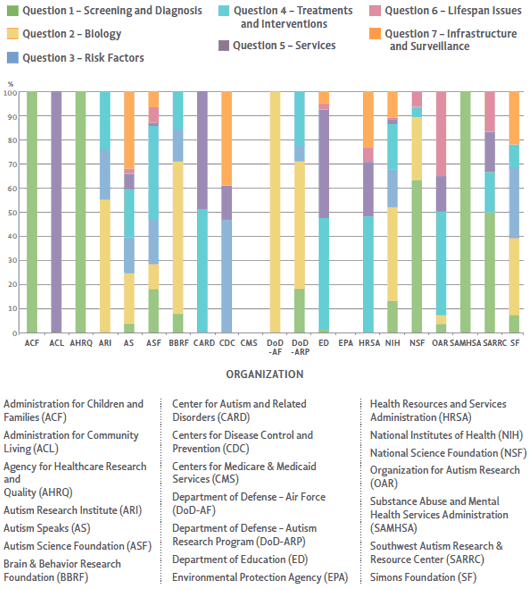
Figure 7. The portfolio of each Federal agency and private organization’s autism-related projects by Strategic Plan question for 2012. Please note that this figure is based on funding amount from 2012. Thus, while funders may support additional areas of research, that may not be reflected in this particular year. For example, AHRQ also supports studies on autism interventions, but did not provide funding for such studies in 2012.
Federal Agency and Private Organization Mission Statements
Federal Agencies – Department of Health and Human Services (HHS)
Administration for Children and Families (ACF)
The mission of ACF is to foster health and well-being by providing Federal leadership, partnership, and
resources for the compassionate and effective delivery of human services. The ACF autism-related research
portfolio includes projects focused on ensuring that effective and culturally appropriate developmental
screening tools and interventions are being developed and deployed in early education settings.
Administration for Community Living (ACL)
Formed in 2012, ACL serves as the Federal agency responsible for increasing access to community supports,
while focusing attention and resources on the unique needs of older Americans and people with disabilities
across the lifespan. ACL funds the AutismNOW web resource, which provides information for the ASD
community on topics including detection, intervention, education, transition from high school into early
adulthood, employment, advocacy, community inclusion, aging issues, and public policy.
Agency for Healthcare Research and Quality (AHRQ)
The mission of AHRQ is to improve the quality, safety, efficiency, and effectiveness of health care for all
Americans. Their portfolio includes projects to evaluate the comparative effectiveness of autism interventions
and to conduct systematic reviews of the literature on topics such as autism screening and autism
interventions, with the goal of evaluating the strength of the evidence supporting practices and identifying
gaps in research. AHRQ also funds projects aimed at disseminating information about best practices
and other findings from their reviews to researchers, practitioners, the patient community, and other
stakeholders.
Centers for Disease Control and Prevention (CDC)
The mission of CDC is to create the expertise, information, and tools that people and communities need to
protect their health. This is achieved through health promotion, prevention of disease, injury and disability,
and preparedness for new health threats. CDC’s autism research portfolio includes projects to collect data on
ASD prevalence and risk factors, and projects to improve awareness, early detection, and intervention.
Centers for Medicare & Medicaid Services (CMS)
CMS administers the Medicare program and works in partnership with State governments to administer
Medicaid, the State Children’s Health Insurance Program (SCHIP), and health insurance portability standards.
CMS funds studies to evaluate ASD service provision, access, and coverage, and has commissioned several
reports on state-provided services for ASD.
Health Resources and Services Administration (HRSA)
HRSA is the primary Federal agency for improving access to health care services for people who are
uninsured, isolated, or medically vulnerable. The Maternal and Child Health Bureau (MCHB) supports
autism-related programs through its Combating Autism Act Initiative (CAAI), including projects to increase
awareness, reduce barriers to screening and diagnosis, promote the development of guidelines for evidencebased
practices, and train health care professionals to provide screening as well as diagnostic and early,
evidence-based intervention. Flagship programs include the Autism Intervention Research Networks (AIR-B and AIR-P), the Developmental Behavioral Pediatrics Research Network (DBPNet), and the Leadership Education in Neurodevelopmental and Related Disabilities (LEND) program.
National Institutes of Health (NIH)
The mission of NIH is to seek fundamental knowledge about the nature and behavior of living systems and
the application of that knowledge to enhance health, lengthen life, and reduce illness and disability. The NIH
supports a broad range of research on ASD, including projects on the basic neuroscience of ASD, risk factors,
diagnosis, intervention, and services research. One of the flagship autism programs funded by NIH, the
Autism Centers of Excellence (ACE), is a collection of research centers and networks across the country that
conduct research on ASD. NIH also funds interdisciplinary data repositories such as the National Database for
Autism Research (NDAR) to facilitate the sharing of autism research data among scientists worldwide.
Substance Abuse and Mental Health Services Administration (SAMHSA)
SAMHSA leads public health efforts to advance the behavioral health of the nation by reducing the impact of
substance abuse and mental illness on America’s communities. SAMHSA funds a project to develop electronic
measures of primary care screening for many conditions, including autism.
Federal Agencies – Other
Department of Defense (DoD)
The Department of Defense (DoD) is charged with coordinating and supervising all agencies and functions
of the government concerned directly with national security and the United States Armed Forces. Within the
DoD’s Defense Health Research Program, the Congressionally Directed Medical Research Program’s Autism
Research Program (ARP) was established in 2007, with the mission to improve the lives of individuals with ASD
by promoting innovative research that advances the understanding of ASD and leads to improved outcomes
for those with ASD. The projects that the ARP funds span the scope of the IACC.
The U.S. Air Force (DOD-AF) also funds research on ASD, and is developing a multidisciplinary autism research and services program for military families, part of which involves the creation of a comprehensive registry to provide higher quality data for autism clinical and genetics research.
Department of Education (ED)
The mission of the U.S. Department of Education is to promote student achievement by fostering educational
excellence and ensuring equal access. The department funds a portfolio of ASD-related projects relating to
development and delivery of educational interventions and services, particularly for children and transitionaged
youth. A large portion of ED’s funding goes towards developing practitioner training as well as
investment in training researchers.
Environmental Protection Agency (EPA)
The mission of the U.S. EPA is to protect human health and the environment. EPA co-funds the Center for
Children’s Environmental Health (CCEH) at the University of California at Davis with the National Institute of
Environmental Health Sciences (NIEHS)/NIH, which conducts research into how environmental exposure to
toxins might interact with a person’s genes and immune system to influence the risk and severity of ASD.
National Science Foundation (NSF)
NSF is an independent Federal agency, formed by Congress to promote the progress of science and to
advance the national health, prosperity, and welfare. NSF funds basic research in biology, mathematics,
computer science, and the social sciences as well as technology development, but it does not focus on
health or disease-related research. Although NSF does not have a program focused on ASD, it funds several
projects that involve basic science or technologies with the potential to be applied to ASD in the future. NSF
is a leading funder of projects involving technological interventions and supports, including robotics and
virtual reality technologies that could be used to enhance daily living skills and activities of individuals with
disabilities.
Private Organizations
Autism Speaks (AS)
AS is the world’s largest autism science and advocacy organization, dedicated to funding research into the
causes, prevention, treatments, and a cure for autism; increasing awareness of autism spectrum disorders;
and advocating for the needs of individuals with autism and their families. AS funds a broad profile of ASD
research ranging from basic neuroscience and the molecular causes of autism to implementation and testing
of interventions for those diagnosed with autism. Autism Speaks supports the Autism Treatment Network, a collaboration of 14 specialty centers dedicated to providing families with state-of-the-art, multidisciplinary
healthcare for children and teens affected by autism.
Autism Research Institute (ARI)
ARI’s mission is to meet the needs of the global autism community through research, networking, education,
and support for families and people of all ages on the autism spectrum. ARI is dedicated to developing a
standard of care for individuals with autism spectrum disorders and their families, and funds a range of work
with a particular emphasis on investigation of the biological underpinnings of autism, including immune and
metabolic pathways.
Autism Science Foundation (ASF)
ASF’s mission is to support autism research by providing funding and other assistance to scientists and
organizations conducting, facilitating, publicizing, and disseminating autism research. The organization also
provides information about autism to the general public and serves to increase awareness of autism spectrum
disorders and the needs of individuals and families affected by autism. ASF funds pre- and postdoctoral
trainees to conduct basic and clinical research relevant to ASD, including studies focused on a wide range of
topics such as identification of biomarkers, molecular and cellular mechanisms, genetic and environmental
risk factors, treatments, and service delivery.
Brain & Behavior Research Foundation (BBRF)
BBRF funds basic neuroscience research to elucidate the molecular mechanisms underlying brain disorders
and conditions. BBRF’s autism research portfolio primarily includes studies on the genetics and molecular
mechanisms underlying autism.
Center for Autism and Related Disorders (CARD)
CARD is one of the world’s largest organizations using applied behavior analysis (ABA) in the treatment of
ASD, and other related disorders. CARD’s research portfolio is centered around developing new behavioral
interventions, assessing existing behavioral interventions, and developing and implementing training/
intervention programs for individuals on the autism spectrum from birth to age 21.
Organization for Autism Research (OAR)
The mission of OAR is to support research that directly impacts the day-to-day quality of life of those
with ASD. This includes research to inform and improve education, communication, self-care, social skills,
employment, behavior, and adult and community living. In this context, it extends to issues related to family
support, the efficacy of service delivery systems, and demographic analyses of the autism community.
Simons Foundation (SF)/Simons Foundation Autism Research Initiative (SFARI)
The mission of SF is to advance the frontiers of research in mathematics and the basic sciences. SF’s single
largest initiative is the Simons Foundation Autism Research Initiative (SFARI), which seeks to improve the
diagnosis and treatment of ASD by funding, catalyzing, and driving innovative research of the greatest
quality and relevance. The SF ASD portfolio includes research on genetic and cellular factors underlying
autism, identification of genetic and environmental risk factors, and development of potential treatments.
Southwest Autism Research & Resource Center (SARRC)
SARRC’s mission is to advance research and provide a lifetime of support for individuals with autism and their
families. SARRC undertakes self-directed research, serves as a satellite site for national and international
projects, and provides up-to-date information, training, and assistance to families and professionals about
autism. Through integrative research, educational outreach, model programs, and collaborative initiatives,
SARRC sets forth, promotes, and facilitates best practices for early intervention and the long-term care of
individuals with ASDs. Their current projects focus on screening tools, data monitoring, and implementing
interventions.
What was the Breakdown of Funding in 2011?
Of the 20 stakeholders, agencies, and organizations that participated in the 2011-2012 Portfolio Analysis, 19 had ASD research projects that were active in 2011. In all, 1,227 projects were funded in 2011, totaling $299,879,145 (Table 3).
The National Institutes of Health (NIH) was the leading Federal (and overall) contributor of funding for ASD research in 2011 with a total of $169.2 million, funding 446 projects. The NIH funding represented an increase from the corresponding 2010 non-ARRA funding level of $159.6 million, but a decrease from the total 2010 funding figure ($217.1 million) which also included $57.5 million in ARRA funding. The next largest Federal funder was the Department of Education, with $29.5 million, followed by the Centers for Disease Control and Prevention (CDC), with $16.1 million. As in previous years, the Simons Foundation and Autism Speaks were the largest private funders of ASD research in 2011, with investments of $50.5 million and $14.9 million, respectively.
2011 ASD Research Funding by Agency/Organization
| Funding Agency/Organization | Project Count | 2011 Funding |
|---|---|---|
Funding Agency/OrganizationNational Institutes of Health (NIH) | Project Count446* |
2011 Funding$169,199,177 |
Funding Agency/OrganizationSimons Foundation (SF) | Project Count185 |
2011 Funding$50,451,927 |
Funding Agency/OrganizationDepartment of Education (ED) | Project Count140 |
2011 Funding$29,529,855 |
Funding Agency/OrganizationCenters for Disease Control and Prevention (CDC) | Project Count28 |
2011 Funding$16,083,474 |
Funding Agency/OrganizationAutism Speaks (AS) | Project Count179 |
2011 Funding$14,872,052 |
Funding Agency/OrganizationHealth Resources and Services Administration (HRSA) | Project Count36 |
2011 Funding$9,950,267** |
Funding Agency/OrganizationDepartment of Defense – Autism Research Program (DoD-ARP) | Project Count72 |
2011 Funding$5,599,296 |
Funding Agency/OrganizationNational Science Foundation (NSF) | Project Count51 |
2011 Funding$1,428,639 |
Funding Agency/OrganizationAdministration for Community Living (ACL) | Project Count1 |
2011 Funding$750,000 |
Funding Agency/OrganizationCenter for Autism and Related Disorders (CARD) | Project Count19 |
2011 Funding$615,801 |
Funding Agency/OrganizationAgency for Healthcare Research and Quality (AHRQ) | Project Count5 |
2011 Funding$491,768** |
Funding Agency/OrganizationAutism Research Institute (ARI) | Project Count16 |
2011 Funding$257,282 |
Funding Agency/OrganizationSouthwest Autism Research & Resource Center (SARRC) | Project Count5 |
2011 Funding$250,000 |
Funding Agency/OrganizationBrain & Behavior Research Foundation (BBRF) | Project Count18 |
2011 Funding$146,730 |
Funding Agency/OrganizationOrganization for Autism Research (OAR) | Project Count14 |
2011 Funding$139,723 |
Funding Agency/OrganizationCenters for Medicare & Medicaid Services (CMS) | Project Count3 |
2011 Funding$88,154 |
Funding Agency/OrganizationAutism Science Foundation (ASF)*** | Project Count7 |
2011 Funding$25,000 |
Funding Agency/OrganizationEnvironmental Protection Agency (EPA) | Project Count1 |
2011 Funding$0 |
Funding Agency/OrganizationDepartment of Defense – Air Force (DoD-AF) | Project Count1 |
2011 Funding$0 |
Funding Agency/OrganizationGrand Total | Project Count1,227 |
2011 Funding$299,879,145 |
*The NIH project number shown reflects unique NIH projects. Projects funded by more than one NIH institute ("co-funds") were combined and only counted as a single project. This approach differs from that used in the NIH RePORT database, where each co-fund is counted as a separate project.
**The annual funding amount for some projects reported by AHRQ and HRSA are prorated estimates for the autism-related portion of a larger project.
***In 2011 ASF made a change in the timing of funding of new grant awards. Funding for some of the 2011 grants was awarded early (in late 2010) and some was awarded late (in early 2012). No funding for new awards was released in 2011, and so only ongoing investments are reported this year. However, some funding from both the 2010 and 2012 cycles supported projects that were being conducted in 2011.
Table 3. The table lists the total funding provided by the 19 Federal agencies and private organizations included in the 2011 Portfolio Analysis and the number of projects funded. Together, the agencies and organizations funded 1,227 projects in 2011, representing an overall investment of $299.9 million.
What was the Breakdown of Funding in 2012?
Each of the 20 stakeholders that participated in the 2011-2012 Portfolio Analysis had ASD research projects that were active in 2012. In all, 1,312 projects were funded in 2012, totaling $331,949,933 (Table 4).
The top three Federal funders of ASD research in 2012 remained the same as 2011. The National Institutes of Health (NIH) was the leading Federal (and overall) contributor of funding for ASD research in 2012 with a total of $190.6 million funding 452 projects, representing an increase from the 2011 funding level of $169.2 million. The next largest Federal funder was the Department of Education (ED) with $29.6 million, followed by the Centers for Disease Control and Prevention (CDC), with $17.2 million. As in previous years, the Simons Foundation and Autism Speaks were the largest private funders of ASD research in 2012, with investments of $56.5 million and $13.0 million, respectively.
2012 ASD Research Funding by Agency/Organization
| Funding Agency/Organization | Project Count | 2011 Funding |
|---|---|---|
Funding Agency/OrganizationNational Institutes of Health (NIH) | Project Count452* |
2011 Funding$190,598,854 |
Funding Agency/OrganizationSimons Foundation (SF) | Project Count247 |
2011 Funding$56,494,115 |
Funding Agency/OrganizationDepartment of Education (ED) | Project Count142 |
2011 Funding$29,628,108 |
Funding Agency/OrganizationCenters for Disease Control and Prevention (CDC) | Project Count27 |
2011 Funding$17,214,124 |
Funding Agency/OrganizationAutism Speaks (AS) | Project Count185 |
2011 Funding$12,993,135 |
Funding Agency/OrganizationHealth Resources and Services Administration (HRSA) | Project Count30 |
2011 Funding$9,400,983** |
Funding Agency/OrganizationNational Science Foundation (NSF) | Project Count44 |
2011 Funding$6,539,622 |
Funding Agency/OrganizationDepartment of Defense – Autism Research Program (DoD-ARP) | Project Count76 |
2011 Funding$4,460,138 |
Funding Agency/OrganizationDepartment of Defense – Air Force (DoD-AF) | Project Count2 |
2011 Funding$903,888 |
Funding Agency/OrganizationCenter for Autism and Related Disorders (CARD) | Project Count17 |
2011 Funding$583,940 |
Funding Agency/OrganizationBrain & Behavior Research Foundation (BBRF) | Project Count31 |
2011 Funding$569,427 |
Funding Agency/OrganizationAgency for Healthcare Research and Quality (AHRQ) | Project Count3 |
2011 Funding$490,038** |
Funding Agency/OrganizationSubstance Abuse and Mental Health Services Administration (SAMHSA) | Project Count1 |
2011 Funding$450,000** |
Funding Agency/OrganizationAutism Science Foundation (ASF)*** | Project Count12 |
2011 Funding$385,000 |
Funding Agency/OrganizationAdministration for Community Living (ACL) | Project Count1 |
2011 Funding$350,000 |
Funding Agency/OrganizationSouthwest Autism Research & Resource Center (SARRC) | Project Count6 |
2011 Funding$300,000 |
Funding Agency/OrganizationOrganization for Autism Research (OAR) | Project Count19 |
2011 Funding$273,182 |
Funding Agency/OrganizationAutism Research Institute (ARI) | Project Count14 |
2011 Funding$215,379 |
Funding Agency/OrganizationAdministration for Children and Families (ACF) | Project Count1 |
2011 Funding$100,000 |
Funding Agency/OrganizationCenters for Medicare & Medicaid Services (CMS) | Project Count1 |
2011 Funding$0 |
Funding Agency/OrganizationEnvironmental Protection Agency (EPA) | Project Count1 |
2011 Funding$0 |
Funding Agency/OrganizationGrand Total | Project Count1,312 |
2011 Funding$331,949,933 |
*The NIH project number shown reflects unique NIH projects and includes a small number of projects not represented in the NIH RePORT autism category. Projects funded by more than one NIH institute (“co-funds”) were combined and only counted as a single project.
**The annual funding amount for some projects reported by AHRQ, HRSA, and SAMHSA are prorated estimates for the autism-related portion of a larger project.
***In 2011 ASF made a change in the timing of funding of new grant awards. Funding for some of the 2011 grants was awarded early (in late 2010) and some was awarded late (in early 2012). No funding for new awards was released in 2011, and so only ongoing investments are reported this year. However, some funding from both the 2010 and 2012 cycles supported projects that were being conducted in 2011.
Table 4. The table lists the total funding provided by the 20 Federal agencies and private organizations included in the 2012 Portfolio Analysis and the number of projects funded. Together, the agencies and organizations funded 1,312 projects in 2012, representing an overall investment of more than $331.9 million.
Summary
As outlined in this section, numerous Federal and private funders invested in ASD research in 2011 and 2012. These investments span the range of topics outlined in the IACC Strategic Plan as well as each funder’s ASD portfolio aligning with their specific mission. A greater number of both Federal and private funders participated in the 2011-2012 Portfolio Analysis Report compared to previous years, contributing to a more comprehensive representation of U.S. ASD research funding. Funding in the overall autism research portfolio, including both Federal and private funders, increased 10.7% from 2011 to 2012. Over the five-year span from 2008 to 2012, funding increased by 49.4%, suggesting overall growth in support for ASD research.


